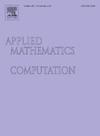Interaction topology optimization by adjustment of edge weights to improve the consensus convergence and prolong the sampling period for a multi-agent system
IF 3.5
2区 数学
Q1 MATHEMATICS, APPLIED
引用次数: 0
Abstract
The second smallest eigenvalue and the largest eigenvalue of the Laplacian matrix of a simple undirected connected graph G are called the algebraic connectivity and the Laplacian spectral radius , respectively. For a first-order periodically sampled consensus protocol multi-agent system (MAS), whose interaction topology can be modeled as a graph G, a larger results in a faster consensus convergence rate, while a smaller contributes to a longer sampling period of the system. Adjusting the weights of the edges is an efficient approach to optimize the interaction topology of a MAS, which improves the consensus convergence rate and prolongs the sampling period. If increases, then the weight of one edge increases, i.e., the increment , and the entries of its eigenvector with respect to and are not equal. If decreases, then the weight of one edge decreases, i.e., the increment , and the entries of its eigenvector with respect to and are not equal. Moreover, when considering adjusting the weights of edges, some necessary conditions for increasing and decreasing are also given respectively, both of which are determined by the entries of their eigenvectors with respect to the vertices of edges and the increment of edge weights. A number of numerical exemplifications are presented to support the theoretical findings.
求助全文
约1分钟内获得全文
求助全文
来源期刊
CiteScore
7.90
自引率
10.00%
发文量
755
审稿时长
36 days
期刊介绍:
Applied Mathematics and Computation addresses work at the interface between applied mathematics, numerical computation, and applications of systems – oriented ideas to the physical, biological, social, and behavioral sciences, and emphasizes papers of a computational nature focusing on new algorithms, their analysis and numerical results.
In addition to presenting research papers, Applied Mathematics and Computation publishes review articles and single–topics issues.

 求助内容:
求助内容: 应助结果提醒方式:
应助结果提醒方式:


